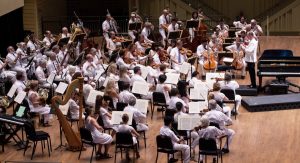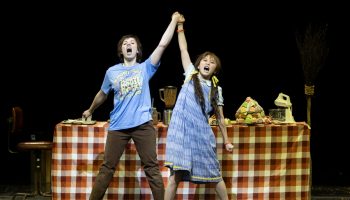
Review by Christopher H. Gibbs:
Chautauqua Institution is uniquely positioned to connect various aspects of its programming over the course of a day, week or summer. The theme of the morning lectures this past week has been “A Planet in Balance,” presented in partnership with National Geographic Society, and on Tuesday evening, the Chautauqua Symphony Orchestra took the opportunity to make some connections between nature and music. Because the concert was part of the “Into the Music/After the Music” series, Music Director Rossen Milanov spoke briefly before the first two compositions to explain some of the intersections.
The concert opened with the marvelous “Cantus Arcticus” by the eminent Finnish composer Einojuhani Rautavaara. For much of the 20th century, audience’s principal association of music and Finland was most likely the towering figure of Jean Sibelius. But in recent decades, the phenomenally active musical life of this small nation has vastly expanded as conductors, singers and instrumentalists crowd the world stage and composers like Magnus Lindberg, Kaija Saariaho and Esa-Pekka Salonen attract ever greater acclaim. Rautavaara, who died in 2016 at age 87, was the elder statesman of the group.
Sibelius himself was the one who selected the young Rautavaara to come to America in the 1950s to study at Tanglewood and Juilliard. Like Sibelius, Rautavaara was deeply connected to the landscape and soundscape of Finland. In 1972, he composed “Cantus Arcticus: A Concerto for Birds and Orchestra,” which went on to become his most-frequently performed and popular piece.
From the Middle Ages to the present day, composers’ attraction to birds seems natural — because it is. While most worldly depictions in music are not immediately obvious (how often, really, do we recognize a particular story in a programmatic work unless we are tipped off by a title or program note?), nature’s own melodists pose few such problems. Whether in a Renaissance madrigal, a Haydn string quartet, a Beethoven or Mahler symphony, or a Wagner opera, bird songs and calls stand out. Some composers — the great French composer Olivier Messiaen, most notably — present these sounds with almost scientific accuracy. Recordings in the modern age expanded the possibilities. In his “Pines of Rome,” Ottorino Respighi introduced a quite extraordinary innovation for the mid-1920s: a phonograph recording of a nightingale.
“Cantus Arcticus” makes use of taped birds, chance techniques and a harmonic language of extraordinary beauty. In three slow movements lasting some 20 minutes, the recorded birds heard on tape are imitated by the instruments of the orchestra. The evocative piece needs to be heard live to appreciate fully the interaction between recorded sound and live orchestra. The Amphitheater is the perfect place to encounter such a piece, connected as it is so organically to nature (granted, we more often hear barking dogs than chirping birds as ambient sound in the Amp, but the open-air setting nonetheless places everyone within a natural space). The CSO is playing extremely well this summer, and under Milanov presented the majestic work most effectively.
The fantastic Nordic landscape then shifted to a Bohemian one: the fourth symphonic poem of Bedřich Smetana’s six-part orchestral masterpiece “Má vlast” (My Country). Although Smetana is generally recognized as the first great Czech Romantic composer (he was born nearly two decades before Antonín Dvořák), much of his aesthetic was actually German — Franz Liszt served as his mentor and model. “Má vlast” displays his native Czech roots as well as his Germanic musical inclinations. Liszt was a pioneer in the single-movement symphonic poem, but I don’t think any of the 13 he composed quite match the six of “Má vlast” in their seamless exploration of different moods.
Vltava (Die Moldau in German) — the cycle’s second part that depicts the river running through the heart of the Czech lands — is much better known than its companion pieces that altogether touch on various aspects of the country’s vistas, history and mythology. What the CSO performed — “From Bohemia’s Forests and Meadows” — is the one most related to nature, to what Smetana called “the rich and beautiful land of Bohemia.” Milanov led a well-balanced and joyous performance, especially in the polka section near the end.
An obvious way to conclude the program would have been with Beethoven’s “Pastoral” Symphony, but Milanov chose a less familiar piece by the composer — the Triple Concerto — and delivered a spirited performance with three terrific young soloists known as the JCT Trio. Although the concerto has no overt connection with nature, Beethoven was one of those composers (Mahler was another) for whom nature was crucial to his existence and creative process. He once remarked in a letter: “No one can love the country as much as I do. For surely woods, trees and rocks produce the echo which man desires to hear,” and he despaired when Napoleon’s troops occupying Vienna meant he could not leave the city: “I still cannot enjoy life in the country, which is so indispensable for me.”
Beethoven communing with birds and flowers may seem at odds with the eccentric genius shaking his fist at fate, but the two images are complementary sides of his personality. The Concerto for Violin, Cello, and Piano in C Major, Op. 56 — to give its official title — shows the composer in a kinder, gentler mood as he looks back in time as well as geographically sideways in its Polish finale. The Triple is a relatively unusual 19th-century concerto in having multiple soloists, something that was common in the 17th and 18th centuries. It is the least performed of his seven mature concertos and is sometimes used as an excuse to bring together star soloists who don’t necessarily have a particularly unified vision of the piece. But the young JCT Trio, consisting of violinist Stefan Jackiw, cellist Jay Campbell and pianist Conrad Tao, not only delivered an engaged and vibrant performance, but also a fully integrated one despite this being the first time they had performed the work together (as they stated in the post-concert discussion). Expertly partnering with the CSO, they were by turns bold, elegant and in the dazzling coda to the final movement, really thrilling.
During the introduction before the concert, Deborah Sunya Moore, vice president of performing and visual arts, and Owen Lee, the CSO’s principal bass, took the opportunity to acknowledge the retirement of bassist Patricia Dougherty, who had played with the orchestra for over 40 years.
Christopher H. Gibbs is the James H. Ottaway Jr. Professor of Music at Bard College, artistic director of the Bard Music Festival, executive editor of The Musical Quarterly and program annotator for The Philadelphia Orchestra. His books include The Life of Schubert, which has been translated into six languages, and the College Edition of The Oxford History of Western Music, co-authored with Richard Taruskin.




